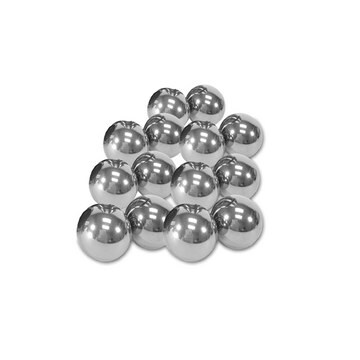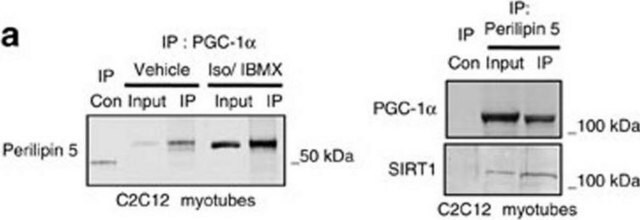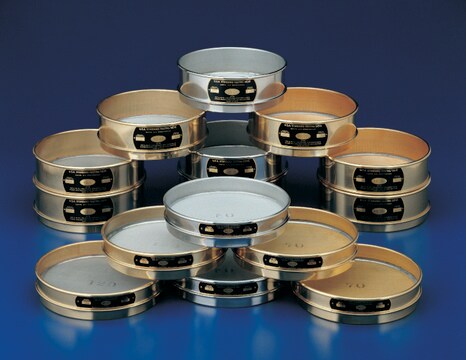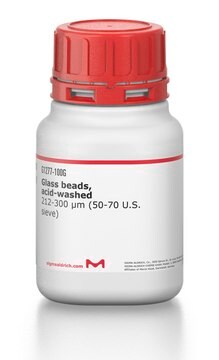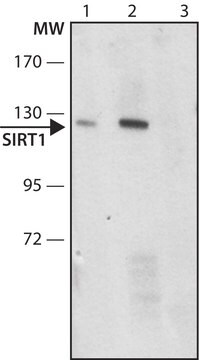05-1243
Anti-Sirt1 Antibody, clone 3H10.2
clone 3H10.2, Upstate®, from mouse
Sign Into View Organizational & Contract Pricing
All Photos(1)
About This Item
UNSPSC Code:
12352203
eCl@ss:
32160702
NACRES:
NA.41
Recommended Products
biological source
mouse
Quality Level
antibody form
purified antibody
antibody product type
primary antibodies
clone
3H10.2, monoclonal
species reactivity
human
manufacturer/tradename
Upstate®
technique(s)
immunoprecipitation (IP): suitable
western blot: suitable
isotype
IgG1
NCBI accession no.
UniProt accession no.
shipped in
wet ice
target post-translational modification
unmodified
Gene Information
human ... SIRT1(23411)
General description
The Sir2 protein in yeast is known to function in transcriptional silencing processes through the deacetylation of histones H3 and H4. The more recently described human homologue of Sir2, known as SIRT1, has been found to associate with the tumor suppressor protein p53. There are now five described human homologs of yeast Sir2, which are named SIRT1-5.
SIRT1 binds and deacetylates p53 with specificity for its C-terminal Lys382 residue in response to the upregulation of promyelocytic leukemia protein (PML) nuclear bodies or oncogenic Ras. The deacetylation of p53 SIRT1 has been shown to negatively regulate p53-mediated transcription, preventing cellular senescence and apoptosis induced by DNA damage and stress. SIRT1 is a HDAC which is important in establishing repressive chromatin structures and plays a role in increasing lifespan.
SIRT1 binds and deacetylates p53 with specificity for its C-terminal Lys382 residue in response to the upregulation of promyelocytic leukemia protein (PML) nuclear bodies or oncogenic Ras. The deacetylation of p53 SIRT1 has been shown to negatively regulate p53-mediated transcription, preventing cellular senescence and apoptosis induced by DNA damage and stress. SIRT1 is a HDAC which is important in establishing repressive chromatin structures and plays a role in increasing lifespan.
Specificity
Human Sirt1. Does not cross react with lysates from mouse NIH/3T3 cells or rat PC12 cells.
Immunogen
GST fusion protein corresponding to amino acids 508-616 of human Sirt1.
Application
Anti-Sirt1 Antibody, clone 3H10.2 is a Mouse Monoclonal Antibody for detection of Sirt1 also known as Sirtuin 1, Silent mating type Information Regulation-2 & has been tested in IP & WB.
Research Category
Epigenetics & Nuclear Function
Epigenetics & Nuclear Function
Research Sub Category
Histones
Histones
Quality
routinely evaluated by immunoblot on nuclear extract from HeLa cells
Target description
120 kDa
Linkage
Replaces: 05-707
Physical form
Format: Purified
Protein G Purified
Purified in PBS with 0.05% Sodium Azide
Storage and Stability
Maintain at 2-8 °C in undiluted aliquots for up to 6 months after date of receipt. Aliquot to avoid repeated freezing and thawing. For maximum recovery of product, centrifuge the original vial after thawing and prior to removing the cap.
Other Notes
Concentration: Please refer to the Certificate of Analysis for the lot-specific concentration.
Legal Information
UPSTATE is a registered trademark of Merck KGaA, Darmstadt, Germany
Disclaimer
Unless otherwise stated in our catalog or other company documentation accompanying the product(s), our products are intended for research use only and are not to be used for any other purpose, which includes but is not limited to, unauthorized commercial uses, in vitro diagnostic uses, ex vivo or in vivo therapeutic uses or any type of consumption or application to humans or animals.
Not finding the right product?
Try our Product Selector Tool.
Storage Class Code
12 - Non Combustible Liquids
WGK
WGK 1
Flash Point(F)
Not applicable
Flash Point(C)
Not applicable
Certificates of Analysis (COA)
Search for Certificates of Analysis (COA) by entering the products Lot/Batch Number. Lot and Batch Numbers can be found on a product’s label following the words ‘Lot’ or ‘Batch’.
Already Own This Product?
Find documentation for the products that you have recently purchased in the Document Library.
Peter J Elliott et al.
Current opinion in investigational drugs (London, England : 2000), 9(4), 371-378 (2008-04-09)
Sirtuins represent a novel family of enzymes that are collectively well situated to help regulate nutrient sensing and utilization, metabolic rate and ultimately metabolic disease. Activation of one of these enzymes, SIRT1, leads to enhanced activity of multiple proteins, including
Oliver Coutelle et al.
EMBO molecular medicine, 6(5), 624-639 (2014-03-22)
In the normal quiescent vasculature, only 0.01% of endothelial cells (ECs) are proliferating. However, this proportion increases dramatically following the angiogenic switch during tumor growth or wound healing. Recent evidence suggests that this angiogenic switch is accompanied by a metabolic
p53 Activation: a case against Sir.
Brooks, Christopher L and Gu, Wei
Cancer Cell, 13, 377-378 (2008)
Hsiang-Yu Chang et al.
Nature communications, 4, 2757-2757 (2013-11-14)
Conformational disorders are involved in various neurodegenerative diseases. Reactive oxygen species (ROS) are the major contributors to neurodegenerative disease; however, ROS that affect the structural changes in misfolded disease proteins have yet to be well characterized. Here we demonstrate that
Timour Prozorovski et al.
Nature cell biology, 10(4), 385-394 (2008-03-18)
Repair processes that are activated in response to neuronal injury, be it inflammatory, ischaemic, metabolic, traumatic or other cause, are characterized by a failure to replenish neurons and by astrogliosis. The underlying molecular pathways, however, are poorly understood. Here, we
Our team of scientists has experience in all areas of research including Life Science, Material Science, Chemical Synthesis, Chromatography, Analytical and many others.
Contact Technical Service
